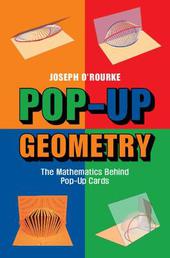
|
Pop-Up Geometry: The Mathematics Behind Pop-Up Cards
Hardback
Main Details
Description
Anyone browsing at the stationery store will see an incredible array of pop-up cards available for any occasion. The workings of pop-up cards and pop-up books can be remarkably intricate. Behind such designs lies beautiful geometry involving the intersection of circles, cones, and spheres, the movements of linkages, and other constructions. The geometry can be modelled by algebraic equations, whose solutions explain the dynamics. For example, several pop-up motions rely on the intersection of three spheres, a computation made every second for GPS location. Connecting the motions of the card structures with the algebra and geometry reveals abstract mathematics performing tangible calculations. Beginning with the nephroid in the 19th-century, the mathematics of pop-up design is now at the frontiers of rigid origami and algorithmic computational complexity. All topics are accessible to those familiar with high-school mathematics; no calculus required. Explanations are supplemented by 140+ figures and 20 animations.
Author Biography
Joseph O'Rourke is Olin Professor of Computer Science and Professor of Mathematics at Smith College. His research is in discrete and computational geometry, developing algorithms for geometric computations. He has won several awards, including a Guggenheim Fellowship in 1987 and the NSF Director's Award for Distinguished Teaching Scholars in 2001. He was named an ACM Fellow in 2012. He has published more than 165 papers, more than 30 of which were coauthored with undergraduates. He has taught folding and unfolding to students in grade school, middle school, high school, college and graduate school, and to teachers at all educational levels, as well as to researchers in mathematics and computer science. This is his seventh book.
Reviews'What a delight! Finally, a book that explains the geometry behind pop-up cards in a simple and straight-forward way with loads of illustrations and web animations to help. I look forward to sharing this gem with my own students.' Thomas Hull, Western New England University 'Pop-Up Geometry is a beautifully written book. This book focuses on the aspect of pop-up structures of computational origami, a recent trend in computational geometry. Once you flip the pages, you will find various colorful figures. These figures nicely give you inspirations of paper art and ideas of the mathematical background of pop-up paper sculptures.' Ryuhei Uehara, Japan Advanced Institute of Science and Technology 'There are many books about pop-ups, but only one about the mathematics of how they work. From analyzing standard pop-up mechanisms to advanced computational design, geometry master O'Rourke gives an excellent tour of this wonderful world.' Erik Demaine, Massachusetts Institute of Technology
|